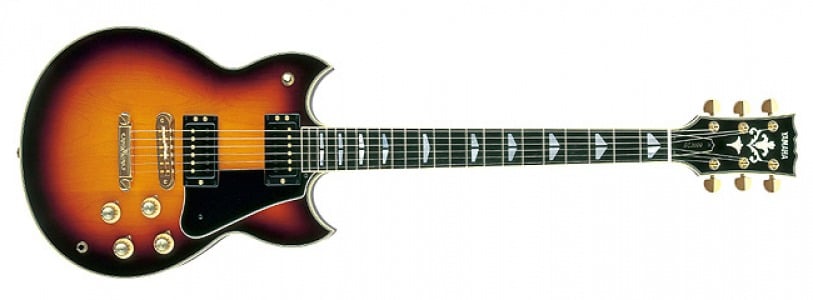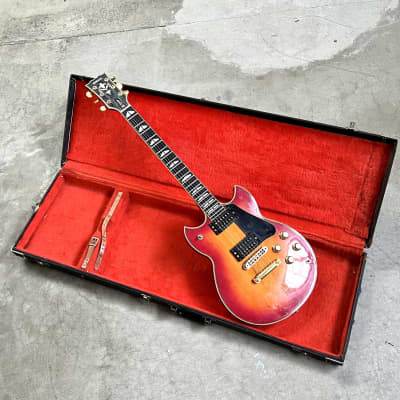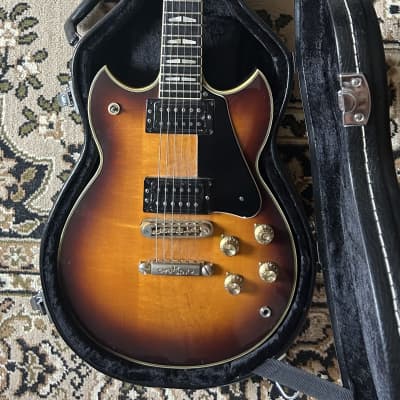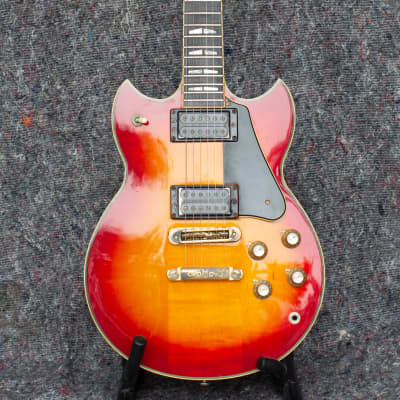Overview
Brand name:
Product:
- electric guitars
Series name:
Dates of manufacture:
The classic Yamaha SG2000 was developed in association with Carlos Santana, and was one of the first electric guitar models that designed specially for distribution in the U.S. First introduced in the 1970s they are still being made and sold today. Guitar Player magazine gave a detailed appraisal of the features of the Yamaha SG2000 in September 1980:
Yamaha’s SG 2000 is a double cutaway electric guitar with a three-piece solid mahogany body with a maple top. It has 22 frets on its 24 3/4" scale ebony fingerboard. The gauges of the strings supplied by the factory are [high to low] 0.011, 0.014, 0.018 (plain) 0.026, 0.035 and 0.046. Action set by Yamaha at the factory measured 3/128" at the nut and 5/64" at the end of the fingerboard for the high E string; for the low E string, the measurements were 2/64" and 7/64". These are reasonable heights, since jumbo frets are used on the SG-2000.
The string nut is 1 9/16" wide, with the strings spaced 7/16" apart (centre to centre). The neck itself is 2 1/4" wide nearest the body; this is similar to the Gibson Les Paul Custom. The neck passes through the entire body, and is constructed of three lengthwise wood laminations. This will usually increase the strength and straightness beyond that of most single-piece necks.
Both the bridge and tailpiece of the SG-2000 are gold plated and are made of cast pot metal (probably zinc?). The bridge rests on a brass sustain b1ock a feature introduced by Alembic several years ago and thereby increases the sustain. Each saddle on the bridge can travel %6", which is about average for this type of configuration.
The tuning machines of the SG2000 are similar to Grovers, but have no identifying manufacturer’s markings. The body of the guitar has a "tummy cut" in the rear portion on top; this allows the player to rest the instrument against his side without getting sore ribs. This feature is similar to that found on some Fender guitars. Located in the neck of the guitar is a single-action steel truss rod which is easily accessible from the top. The manufacturer provides the correct truss rod adjusting tool with a Phillips screwdriver tip at the opposite end.
The neck angle in relation to the body axis was measured at 6.5°, which is steeper than average (about 4°) for a guitar of this scale length. This in turn affects the bridge and pickup heights. In relation to the fingerboard, the peghead angle is 14° again steeper than average (12°), but somewhat less critical than the neck angle. This increased peghead angle will create greater string tension at the nut, and might add some extra sustain. Electronics are the basis of the sound of most electric guitars.
The pickups employed on the SG 2000 are humbuckers with metallic covers that expose both coils of each pickup to the strings. There are three adjusters for pickup height two on one side and one on the other (similar to Guild guitars)-thereby allowing better tilt control of the pickup than if there were only two. The pickups are capable of a 1.34-volt AC output, which would be considered "medium hot". ("Hot" pickups usually put out 1.75 to 2.0 volts. low-output models generate less than 1 volt, and those in the "medium hot" range create about 1.5 volts.)
The height of both pickups set by the factory was l/8", and the magnetic output of each was average- about +24 gauss. The impedance (DC resistance. measured in ohms) of the pickups was 7.000 (Gibson humbuckers measure about 8.000 ohms); this gives the Yamaha a very midrange-oriented sound. The pickup selector switch used in the SG 2000 is similar to the "standard" Switchcraft model used in most American guitars a vast improvement over most Japanese instrument switches.
Guitar player magazine (September 1980) had the following criticisms of the SG 2000:
While the neck feels good, its back has a different radius from that of most other solid bodies, giving it a ‘chunkier" feel. This is neither a detrimental quality nor an especially noteworthy one; its appeal depends completely upon individual taste.
The gold plating had worn off of some parts of the bridge and saddle on an SG-2000 which had been in use for a year. This is normal for gold plating, but it could be improved. (The finish of this same guitar was in excellent shape, however.)
The guitar’s intonation was checked using a Peterson 700 strobe tuner, and when properly intonated, there was room for the saddles to travel in either direction; this indicates accurate bridge placement. T
The tuning machines of the SG 2000 are among the finest we have seen on factory-made guitars
The placement of the strap button on the centre of the reverse side of the neck seems poor because it’s in your way w hen you finger up high.
The volume and tone pots, however, seem to have poor tapers; their effect on the sound is not directly proportional to the rate at which they are turned. Also, they are not sealed, which makes them vulnerable to dust. However, the subject of pots is very complex, and many manufacturers use pots of similar quality.
The interior wiring of the guitar is color coded coaxial shielded cable throughout. This is very good for keeping noise out of the audio signal Conductive shielding paint is used on the interior of the guitar’s control cavity a very good idea. However, more of the same paint is located beneath both of the pickups, but it is not connected to a ground point, rendering it useless.
In summing up, the guitar is quite sound, with personality and integrity. It is finely crafted, and worthy of a certain praise, considering that this is one of the first electric guitar models that Yamaha has produced for distribution in the U.S.
Dan Smith, Yamaha’s product specialist for guitars and amps, responded to the criticisms from Guitar Player:
"The bridge and tailpiece are most likely zinc castings; the saddles, however, are machined brass. Also, I don’t think it’s uncommon for some of the gold plating to wear off of these parts through normal use. In fact, all gold-plated hardware is subject to the same type of wear because it’s constantly in contact with the oils and secretions of the skin. Gold plating is expensive to maintain, and simply isn’t as durable as chrome plating. From my own experience, I’ve found that the best way to help preserve the gold plating is to wipe it occasionally with a clean, dry rag. It seems that waxes and cleaners are often abrasive, so you may want to avoid them altogether.The SG-2000’s finish is very durable, and is composed of a polyester base with a polyurethane top coating.
As far as the strap button’s location is concerned. I think that it is debatable whether it poses a problem for guitarists. Many fine guitars by other manufacturers have similar strap button placement, and most players don’t find it troublesome. We chose to place it in the centre, rather than on the shoulder, for two reasons: to maintain even balance and to keep its double-cutaway symmetry undisturbed.
The volume and tone pots are specially tapered to our specifications. and should in fact operate smoothly over their entire range. The shielding in the control cavity is grounded. but we don’t feel it’s necessary to shield the pickup cavity as well"
Smith also notes that the SG-2000 is sold with a specially-fit case, and has a detailed service manual to aid in uniform maintenance of the guitar.
"lf the instrument is not set up to the specifications detailed in the manual.` says Smith, "Then the guitar may not always perform at its best. Action, pickup height, neck bow all the various adjustments will affect it. We spend from one to one—and-a-half hours setting up every guitar at our U.S. plant after the instrument arrives from Japan. After that, we have no control over the humidity, temperature and so forth. By following the manual’s instructions, and adjusting the guitar accordingly, the guitarist will be able to get the most out of the SG 2000."
Reference:
Guitar Players product profile: The Yamaha SG-2000 electric guitar. Guitar Player, September 1980.
Specifications
Prices (4)
| Date | Price | Condition | Name | Comments |
|---|---|---|---|---|
| 2014 | €1200 | good | ||
| 1992 | $250.00 | excellent | Gary | As fine a short scale, solidbody, dual humbucking electric guitar as you will find. Custom shop quality/feel/playability/sound. Simply sublime. Too bad Yamaha "improve" the current SG1820 series into a different guitar entirely. |
| 1980 | £150 | good | john | Deep red |
| 1980 | $500. | excellent | Dang! | Amazing guitar!!! One of my very best purchases!!! |




